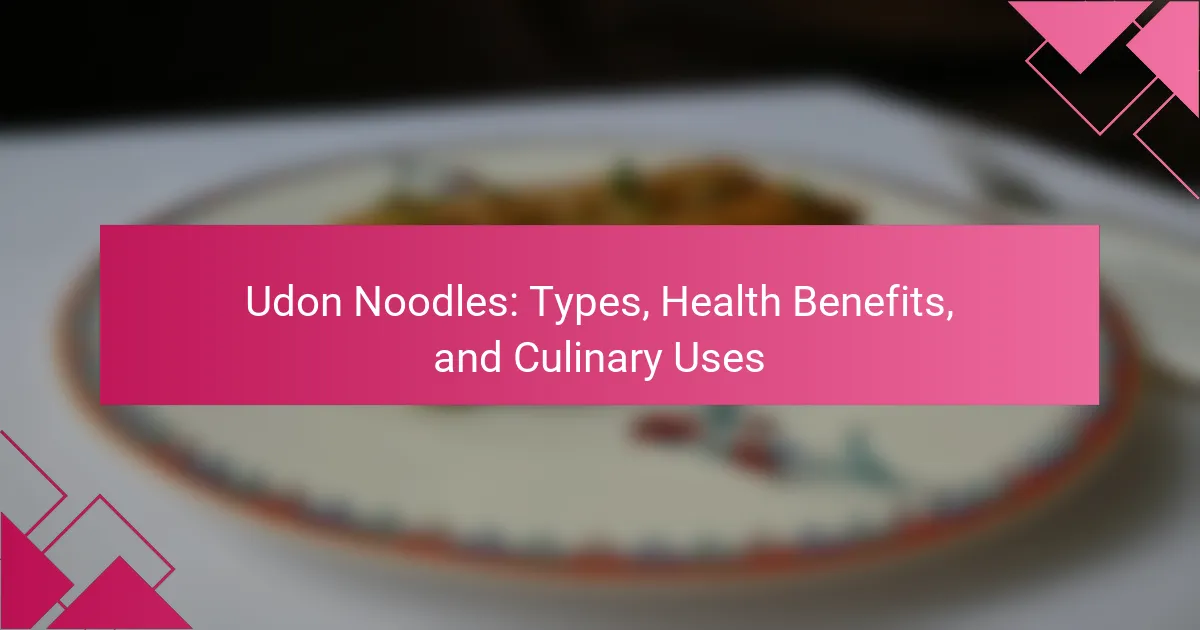
What are Udon Noodles?
Udon noodles are thick, chewy Japanese wheat noodles. They are made from flour, water, and salt. Udon noodles are typically served in a broth or stir-fried. They are often paired with various toppings like green onions, tempura, or tofu. Udon has a long history in Japan, dating back to at least the 9th century. These noodles are known for their versatility in different dishes. Udon can be enjoyed hot or cold, depending on the preparation. They are a staple in Japanese cuisine and are popular worldwide.
How are Udon Noodles made?
Udon noodles are made from wheat flour, water, and salt. The process begins by mixing the ingredients to form a dough. This dough is then kneaded until smooth and elastic. After kneading, the dough is allowed to rest for about 30 minutes. Once rested, the dough is rolled out into a thin sheet. The sheet is then cut into thick strips to form the noodles. Finally, the noodles are boiled in water until they are cooked through. Udon noodles are typically served in a broth or stir-fried with various ingredients.
What ingredients are essential for Udon Noodles?
Essential ingredients for Udon noodles include wheat flour, water, and salt. Wheat flour is the primary component that gives Udon its structure. Water hydrates the flour, enabling gluten development, which is crucial for texture. Salt enhances flavor and aids in gluten formation. These three ingredients are fundamental in traditional Udon noodle recipes. Variations may include additional elements like kansui, an alkaline mineral water, which improves the noodle’s elasticity and color.
What is the process of making Udon Noodles?
The process of making Udon noodles involves mixing flour, water, and salt. First, the ingredients are combined to form a dough. The dough is then kneaded until smooth and elastic. After kneading, the dough is allowed to rest for about 30 minutes. Next, the rested dough is rolled out into a flat sheet. The sheet is then cut into thick strips to create the noodles. Finally, the noodles are boiled in water until cooked through. Udon noodles typically take 8 to 12 minutes to cook.
What types of Udon Noodles are there?
There are several types of udon noodles. The main types include Sanuki udon, which is known for its firm texture and originates from Kagawa Prefecture. Another type is Nishin udon, often served with herring and popular in Kyoto. There is also Inaniwa udon, recognized for its thin and smooth characteristics, originating from Akita Prefecture. Additionally, there are variations like Yaki udon, which are stir-fried noodles. Each type of udon has unique qualities that cater to different culinary preferences and regional specialties.
What are the different styles of Udon Noodles?
Udon noodles come in various styles, each with unique characteristics. The most common types include Sanuki udon, known for its firm texture and chewy bite. Another style is Nishin udon, which features a broth made with herring. Kake udon is a simple dish served in a hot broth, often with green onions. Yaki udon is stir-fried udon, typically mixed with vegetables and protein. Lastly, Nabeyaki udon is served in a hot pot, often topped with tempura, vegetables, and an egg. These styles highlight the versatility of udon noodles in Japanese cuisine.
How do regional variations affect Udon Noodles?
Regional variations significantly affect Udon noodles in terms of texture, thickness, and flavor. Different regions in Japan produce Udon with unique characteristics. For example, Kagawa Prefecture is known for its thin, firm noodles, while Osaka prefers thicker, chewier varieties. The ingredients used also vary regionally, influencing the taste and color of the noodles. In some areas, local wheat varieties are used, which alters the flavor profile. Additionally, the style of serving Udon differs by region. Some regions serve it hot in broth, while others offer it cold with dipping sauces. These variations reflect local culinary traditions and preferences.

What are the health benefits of Udon Noodles?
Udon noodles offer several health benefits. They are low in calories, making them a suitable option for weight management. Udon noodles are primarily made from wheat flour, which provides carbohydrates for energy. They also contain some protein, contributing to muscle repair and growth. Additionally, udon noodles are often served in broth, which can enhance hydration. Some varieties are enriched with vitamins and minerals, such as iron and B vitamins. Whole grain udon noodles contain more fiber, aiding in digestion and promoting gut health. Overall, incorporating udon noodles into a balanced diet can support overall wellness.
Why are Udon Noodles considered a healthy option?
Udon noodles are considered a healthy option due to their low fat content and high carbohydrate levels. They are primarily made from wheat flour, water, and salt, making them a good source of energy. Udon noodles are typically low in calories compared to other pasta varieties. A standard serving contains about 200 calories. They also provide essential nutrients such as iron and B vitamins. Additionally, when served with vegetables and lean proteins, they can contribute to a balanced diet. Many people also find them easy to digest. This digestibility can be beneficial for those with sensitive stomachs. Overall, udon noodles can be a nutritious choice when part of a well-rounded meal.
What nutritional components do Udon Noodles contain?
Udon noodles primarily contain carbohydrates, protein, and small amounts of fat. A typical serving of udon noodles provides around 210 calories. They are composed mainly of wheat flour, which contributes to their carbohydrate content. Udon noodles also contain some dietary fiber, though in limited amounts. Each serving usually has about 7 grams of protein. Additionally, they may contain trace minerals such as iron and calcium. The nutritional profile can vary slightly based on the specific recipe or brand.
How do Udon Noodles fit into a balanced diet?
Udon noodles can fit into a balanced diet as a source of carbohydrates. They provide energy essential for daily activities. Udon noodles are typically made from wheat flour, water, and salt. This composition makes them a good source of complex carbohydrates. A serving of udon noodles contains about 200 calories, which can contribute to daily caloric intake. They are low in fat, containing less than 1 gram per serving. Udon noodles can be paired with vegetables and protein sources for a more balanced meal. Including these ingredients enhances the nutritional profile of the dish.
What dietary considerations should be made with Udon Noodles?
Udon noodles are primarily made from wheat flour, which means they contain gluten. Individuals with celiac disease or gluten sensitivity should avoid udon noodles. Udon noodles are high in carbohydrates, providing a quick source of energy. However, they lack significant protein and fiber content compared to whole grain alternatives. For those monitoring their carbohydrate intake, portion control is important. Additionally, udon noodles can be high in sodium, depending on preparation methods and sauces used. It’s beneficial to pair them with vegetables and lean proteins for a balanced meal. Nutritional information varies by brand, so checking labels is recommended for specific dietary needs.
Are Udon Noodles suitable for gluten-free diets?
Udon noodles are not suitable for gluten-free diets. Traditional udon noodles are made from wheat flour, which contains gluten. Gluten is a protein that can cause adverse reactions in individuals with gluten sensitivities or celiac disease. Therefore, those adhering to a gluten-free diet must avoid standard udon noodles. Gluten-free alternatives may be available, but they are not considered traditional udon.
How can Udon Noodles be incorporated into various dietary preferences?
Udon noodles can be incorporated into various dietary preferences by offering versatile meal options. For vegetarians, udon can be served in vegetable broth with a variety of fresh vegetables. Vegans can enjoy udon with plant-based protein sources like tofu or tempeh. Gluten-free diets can utilize alternative flours, such as rice flour, to create gluten-free udon varieties. Low-carb diets can feature shirataki noodles as a substitute, which mimic udon in texture.
In traditional Japanese cuisine, udon is often paired with broth and seasonal ingredients, making it adaptable to different dietary needs. The noodles can also be stir-fried with vegetables and sauces for a quick meal. Nutritionally, udon provides carbohydrates for energy, which can be balanced with protein and fiber from added ingredients.
This flexibility makes udon noodles suitable for many dietary lifestyles, allowing for creativity and variety in meal preparation.

How are Udon Noodles used in culinary practices?
Udon noodles are used in various culinary practices primarily in Japanese cuisine. They are often served in hot broth as a noodle soup dish. This soup typically includes dashi, soy sauce, and mirin for flavor. Udon can also be stir-fried with vegetables and proteins, creating a savory dish. Another common preparation is serving them cold with dipping sauces, especially during summer. Udon noodles are versatile and can be paired with different toppings, such as scallions, tempura, or egg. Their chewy texture complements a wide range of flavors in dishes. Udon’s popularity extends beyond Japan, influencing global cuisine.
What are popular dishes featuring Udon Noodles?
Popular dishes featuring Udon noodles include Yaki Udon, Udon Soup, and Nabeyaki Udon. Yaki Udon is stir-fried with vegetables and proteins. Udon Soup is a traditional dish served in a savory broth. Nabeyaki Udon is a hot pot version with added ingredients like tempura. These dishes highlight the versatility of Udon noodles in Japanese cuisine. Udon’s thick, chewy texture complements various flavors and ingredients. They are often garnished with green onions, seaweed, or sesame seeds. Udon noodles are enjoyed for their ability to absorb flavors in soups and stir-fries.
How can Udon Noodles be prepared in traditional recipes?
Udon noodles can be prepared in traditional recipes by boiling them until tender, typically for about 10 minutes. After boiling, they should be drained and rinsed under cold water to stop the cooking process. Traditional dishes often include a broth made from dashi, soy sauce, and mirin. The noodles can be served in this broth with toppings like green onions, tempura, or mushrooms. Another common preparation involves stir-frying the noodles with vegetables and protein. Udon is also enjoyed cold, served with a dipping sauce. These methods reflect the versatility and cultural significance of udon in Japanese cuisine.
What modern culinary trends involve Udon Noodles?
Modern culinary trends involving udon noodles include fusion cuisine and plant-based dishes. Chefs are incorporating udon into various global flavors. For example, udon is often featured in ramen-style bowls with unique broths. Another trend is the use of udon in salads, combining it with fresh vegetables and dressings. Udon is also being served in stir-fries, showcasing its versatility. The rise of vegan and vegetarian diets has led to more plant-based udon recipes. Additionally, the trend of meal kits includes udon as a quick cooking option. These trends highlight the adaptability of udon noodles in contemporary cooking.
What tips can enhance the cooking of Udon Noodles?
To enhance the cooking of udon noodles, use plenty of water when boiling. This prevents the noodles from sticking together. Boil the noodles for about 8 to 10 minutes until they are tender but still chewy. Rinse the cooked noodles under cold water to stop the cooking process. This also helps remove excess starch. For added flavor, incorporate a dash of soy sauce or sesame oil during cooking. Serve the noodles immediately for the best texture. Udon noodles are best enjoyed in broth or with sauces, enhancing their flavor profile.
How can one achieve the perfect texture when cooking Udon Noodles?
To achieve the perfect texture when cooking udon noodles, use the right water temperature. Boil water at a rolling boil before adding the noodles. Cook the noodles for about 8 to 12 minutes, depending on their thickness. Stir occasionally to prevent sticking. Test the noodles for doneness by tasting them. They should be firm yet chewy, known as “al dente.” After cooking, drain the noodles and rinse them under cold water. This stops the cooking process and removes excess starch, improving texture. Proper cooking time and rinsing ensure udon noodles have the desired smooth and chewy consistency.
What common mistakes should be avoided when preparing Udon Noodles?
Common mistakes to avoid when preparing Udon noodles include using insufficient water during cooking. This can lead to uneven cooking and a sticky texture. Another mistake is overcooking the noodles, which results in a mushy consistency. Not rinsing the noodles after cooking can also be problematic. Rinsing removes excess starch and prevents clumping. Additionally, neglecting to follow the package instructions can affect the final dish. Each brand may have specific cooking times and methods. Lastly, failing to use a proper pot size can cause overcrowding, leading to uneven cooking. These mistakes can diminish the quality of the dish significantly.
Udon noodles are thick, chewy Japanese wheat noodles made from flour, water, and salt, known for their versatility in various dishes. This article covers the types of udon noodles, including Sanuki, Nishin, and Yaki udon, along with the traditional and modern culinary practices that incorporate them. It also highlights the health benefits of udon, such as being low in calories and a source of carbohydrates, while discussing dietary considerations for gluten sensitivity. Additionally, tips for cooking udon noodles to achieve the perfect texture and avoid common mistakes are provided, making it a comprehensive guide to understanding and enjoying udon noodles.
